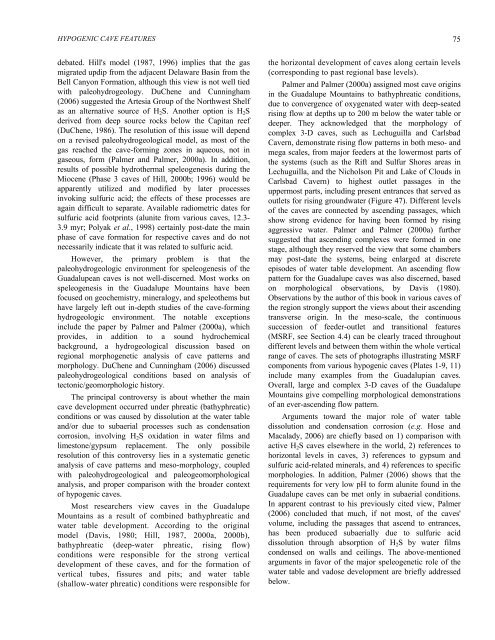Download PDF - Speleogenesis
Download PDF - Speleogenesis
Download PDF - Speleogenesis
You also want an ePaper? Increase the reach of your titles
YUMPU automatically turns print PDFs into web optimized ePapers that Google loves.
HYPOGENIC CAVE FEATURES<br />
debated. Hill's model (1987, 1996) implies that the gas<br />
migrated updip from the adjacent Delaware Basin from the<br />
Bell Canyon Formation, although this view is not well tied<br />
with paleohydrogeology. DuChene and Cunningham<br />
(2006) suggested the Artesia Group of the Northwest Shelf<br />
as an alternative source of H2S. Another option is H2S<br />
derived from deep source rocks below the Capitan reef<br />
(DuChene, 1986). The resolution of this issue will depend<br />
on a revised paleohydrogeological model, as most of the<br />
gas reached the cave-forming zones in aqueous, not in<br />
gaseous, form (Palmer and Palmer, 2000a). In addition,<br />
results of possible hydrothermal speleogenesis during the<br />
Miocene (Phase 3 caves of Hill, 2000b; 1996) would be<br />
apparently utilized and modified by later processes<br />
invoking sulfuric acid; the effects of these processes are<br />
again difficult to separate. Available radiometric dates for<br />
sulfuric acid footprints (alunite from various caves, 12.3-<br />
3.9 myr; Polyak et al., 1998) certainly post-date the main<br />
phase of cave formation for respective caves and do not<br />
necessarily indicate that it was related to sulfuric acid.<br />
However, the primary problem is that the<br />
paleohydrogeologic environment for speleogenesis of the<br />
Guadalupean caves is not well-discerned. Most works on<br />
speleogenesis in the Guadalupe Mountains have been<br />
focused on geochemistry, mineralogy, and speleothems but<br />
have largely left out in-depth studies of the cave-forming<br />
hydrogeologic environment. The notable exceptions<br />
include the paper by Palmer and Palmer (2000a), which<br />
provides, in addition to a sound hydrochemical<br />
background, a hydrogeological discussion based on<br />
regional morphogenetic analysis of cave patterns and<br />
morphology. DuChene and Cunningham (2006) discussed<br />
paleohydrogeological conditions based on analysis of<br />
tectonic/geomorphologic history.<br />
The principal controversy is about whether the main<br />
cave development occurred under phreatic (bathyphreatic)<br />
conditions or was caused by dissolution at the water table<br />
and/or due to subaerial processes such as condensation<br />
corrosion, involving H2S oxidation in water films and<br />
limestone/gypsum replacement. The only possibile<br />
resolution of this controversy lies in a systematic genetic<br />
analysis of cave patterns and meso-morphology, coupled<br />
with paleohydrogeological and paleogeomorphological<br />
analysis, and proper comparison with the broader context<br />
of hypogenic caves.<br />
Most researchers view caves in the Guadalupe<br />
Mountains as a result of combined bathyphreatic and<br />
water table development. According to the original<br />
model (Davis, 1980; Hill, 1987, 2000a, 2000b),<br />
bathyphreatic (deep-water phreatic, rising flow)<br />
conditions were responsible for the strong vertical<br />
development of these caves, and for the formation of<br />
vertical tubes, fissures and pits; and water table<br />
(shallow-water phreatic) conditions were responsible for<br />
the horizontal development of caves along certain levels<br />
(corresponding to past regional base levels).<br />
Palmer and Palmer (2000a) assigned most cave origins<br />
in the Guadalupe Mountains to bathyphreatic conditions,<br />
due to convergence of oxygenated water with deep-seated<br />
rising flow at depths up to 200 m below the water table or<br />
deeper. They acknowledged that the morphology of<br />
complex 3-D caves, such as Lechuguilla and Carlsbad<br />
Cavern, demonstrate rising flow patterns in both meso- and<br />
mega scales, from major feeders at the lowermost parts of<br />
the systems (such as the Rift and Sulfur Shores areas in<br />
Lechuguilla, and the Nicholson Pit and Lake of Clouds in<br />
Carlsbad Cavern) to highest outlet passages in the<br />
uppermost parts, including present entrances that served as<br />
outlets for rising groundwater (Figure 47). Different levels<br />
of the caves are connected by ascending passages, which<br />
show strong evidence for having been formed by rising<br />
aggressive water. Palmer and Palmer (2000a) further<br />
suggested that ascending complexes were formed in one<br />
stage, although they reserved the view that some chambers<br />
may post-date the systems, being enlarged at discrete<br />
episodes of water table development. An ascending flow<br />
pattern for the Guadalupe caves was also discerned, based<br />
on morphological observations, by Davis (1980).<br />
Observations by the author of this book in various caves of<br />
the region strongly support the views about their ascending<br />
transverse origin. In the meso-scale, the continuous<br />
succession of feeder-outlet and transitional features<br />
(MSRF, see Section 4.4) can be clearly traced throughout<br />
different levels and between them within the whole vertical<br />
range of caves. The sets of photographs illustrating MSRF<br />
components from various hypogenic caves (Plates 1-9, 11)<br />
include many examples from the Guadalupian caves.<br />
Overall, large and complex 3-D caves of the Guadalupe<br />
Mountains give compelling morphological demonstrations<br />
of an ever-ascending flow pattern.<br />
Arguments toward the major role of water table<br />
dissolution and condensation corrosion (e.g. Hose and<br />
Macalady, 2006) are chiefly based on 1) comparison with<br />
active H2S caves elsewhere in the world, 2) references to<br />
horizontal levels in caves, 3) references to gypsum and<br />
sulfuric acid-related minerals, and 4) references to specific<br />
morphologies. In addition, Palmer (2006) shows that the<br />
requirements for very low pH to form alunite found in the<br />
Guadalupe caves can be met only in subaerial conditions.<br />
In apparent contrast to his previously cited view, Palmer<br />
(2006) concluded that much, if not most, of the caves'<br />
volume, including the passages that ascend to entrances,<br />
has been produced subaerially due to sulfuric acid<br />
dissolution through absorption of H2S by water films<br />
condensed on walls and ceilings. The above-mentioned<br />
arguments in favor of the major speleogenetic role of the<br />
water table and vadose development are briefly addressed<br />
below.<br />
75
















